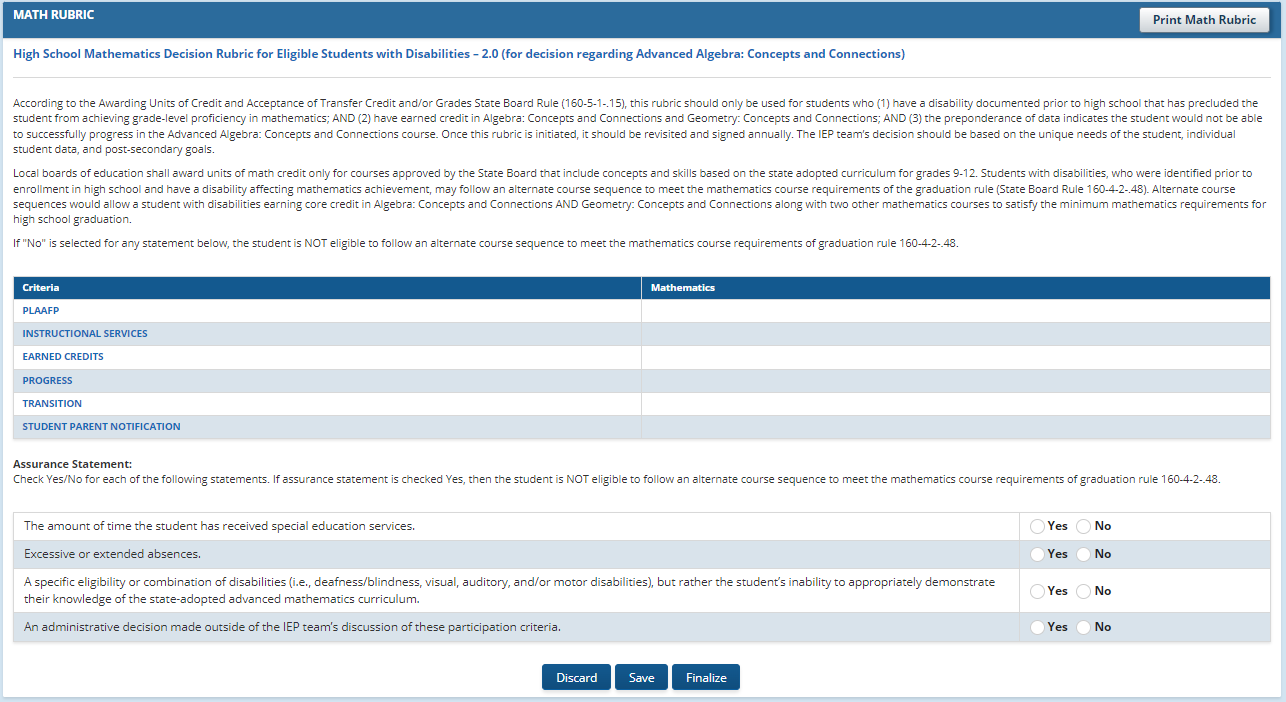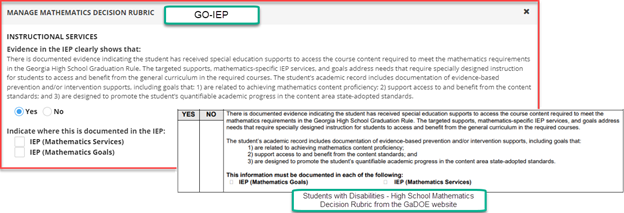Math Rubric (2.0)
High School Mathematics Decision Rubric for Eligible Students with Disabilities – 2.0 (for decision regarding Advanced Algebra: Concepts and Connections)
Some students are eligible to complete an alternate math course sequence in high school. This form is optional and should only be completed if the IEP committee thinks a student may benefit. In GO-IEP, the Math Rubric will only be available to complete for students who are in the 10th grade or higher since the rule requires the student to have earned course credit for the first Algebra course and the first Geometry course before being eligible for the alternate sequence.
According to the Awarding Units of Credit and Acceptance of Transfer Credit and/or Grades State Board Rule (160-5-1-.15), this rubric should only be used for students who (1) have a disability documented prior to high school that has precluded the student from achieving grade-level proficiency in mathematics; AND (2) have earned credit in Algebra: Concepts and Connections and Geometry: Concepts and Connections; AND (3) the preponderance of data indicates the student would not be able to successfully progress in the Advanced Algebra: Concepts and Connections course. Once this rubric is initiated, it should be revisited and signed annually. The IEP team’s decision should be based on the unique needs of the student, individual student data, and post-secondary goals.
Local boards of education shall award units of math credit only for courses approved by the State Board that include concepts and skills based on the state-adopted curriculum for grades 9-12. Students with disabilities, who were identified prior to enrollment in high school and have a disability affecting mathematics achievement, may follow an alternate course sequence to meet the mathematics course requirements of the graduation rule (State Board Rule 160-4-2-.48). Alternate course sequences would allow a student with disabilities earning core credit in Algebra: Concepts and Connections AND Geometry: Concepts and Connections along with two other mathematics courses to satisfy the minimum mathematics requirements for high school graduation.
To complete the math rubric, program users will click on each of the blue links listed under "Criteria".

When the Math Rubric tab in GO-IEP is selected, the Students with Disabilities – High School Mathematics Decision Rubric from the GaDOE website is available to document eligibility for participation in an Alternate Math Sequence for graduation.
The selection options that are needed for each question on the rubric are available when the question topic header is selected.

A text field is available for the additional summary statements if needed and the assurance statements are also available.
To complete the math rubric, program users will click on each of the blue links listed under "Criteria". If "No" is selected for any criteria statement in the rubric, the student is NOT eligible to follow an alternate course sequence to meet the mathematics course requirements of graduation rule 160-4-2-.48.

Program users will answer the questions that appear after each link Yes or No. Other than the Student/Parent Notification question, if the question is answered "Yes", program users are required to indicate where the responses related to the question are documented in the IEP.

After the criteria questions are completed and saved, the answers will appear on the rubric screen.

Next program users must complete the Assurance Statement section and save the selections. Any Assurance Statement with an answer of "Yes" will result in the student being ineligible for participation in the alternate math sequence.

Save allows users to enter information and come back to complete the worksheet later.
If the Rubric was started in error or needs to be cleared, Discard is available.
Once the decision is made, it must be finalized. When Finalize is selected, audits may show indicating missing information.

When the IEP is printed, the math rubric will print in both the draft and final pdfs with a signature page that must be signed. If the final decision is NO, the signature page will not print.
After finalizing a decision, the rubric can be re-opened if needed to make changes using the RE-OPEN button.

Once completed, the rubric should be completed annually if the student will be graduating following the Alternate Math Course Sequence, even if the student has met all Alternate Math requirements.
If the student is eligible to complete an alternate math course sequence, math should be included as an area of weakness within the present level even if the student will not be taking math courses during the current IEP period.
A student’s IEP should reflect math services to enable the student to complete each of the math requirements for the Alternate Math Sequence.
If the student will not be taking a required math course during the effective dates of an IEP, the answer to the impact question within the present level related to math should still say YES, and the team would have to decide if the weakness is going to be addressed and if so, where that will be documented in the IEP.
Students who have completed the math requirements may be taking a math course and have an IEP service for math. Students who are not taking a math course or receiving a math service might continue to have IEP goals or Transition Plan Annual Goals for shopping skills, telling time, measuring, managing money or other math skills. In those cases, in the math rubric, select YES to the Instructional Supports question and document in the minutes that math services and/or goals were included in prior IEPs but are not in the current IEP because the student has completed all required math courses.
Math Rubric Report:
Teachers, School Admins, and System Admins can go to the Reports in GO-IEP and view the Math Rubric Report for a list of all students who are currently eligible to participate in the alternate math sequence.